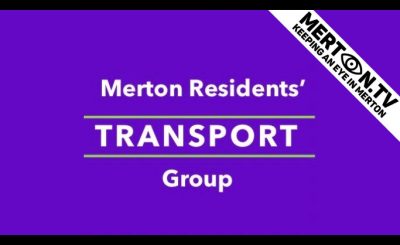https://us02web.zoom.us/j/82653941717
- Update from council
- Formalising a committee
- Allocation of tasks within subgroups
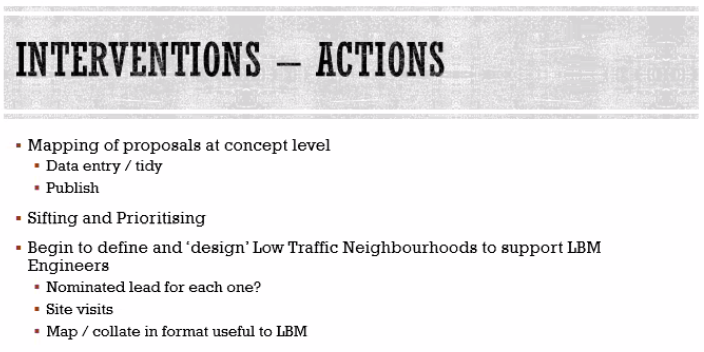
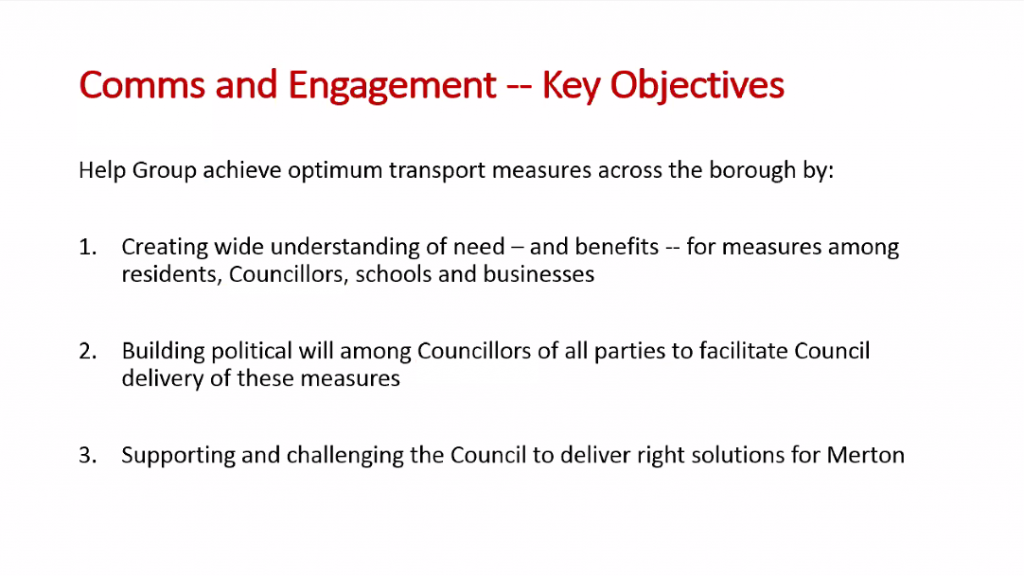
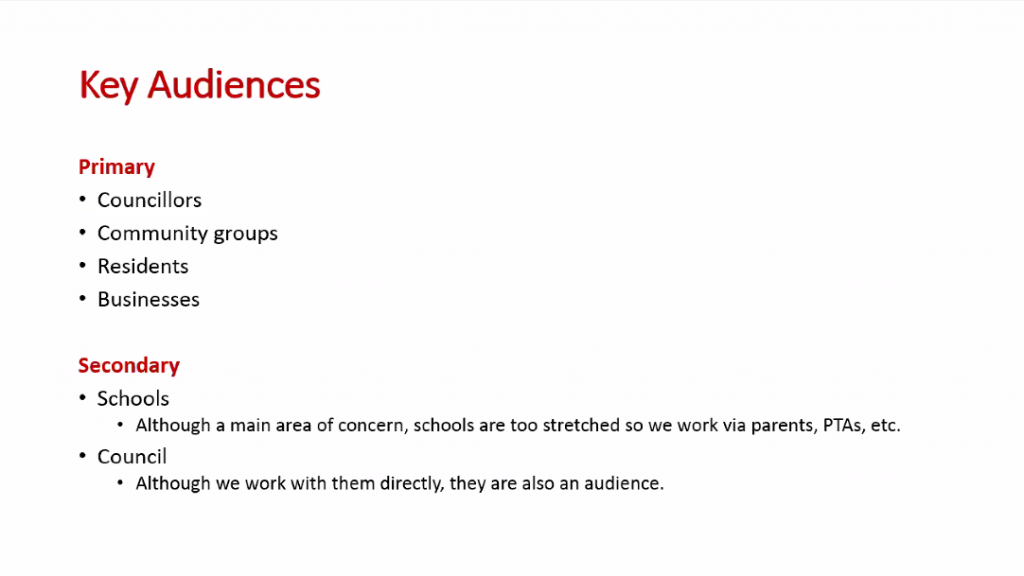
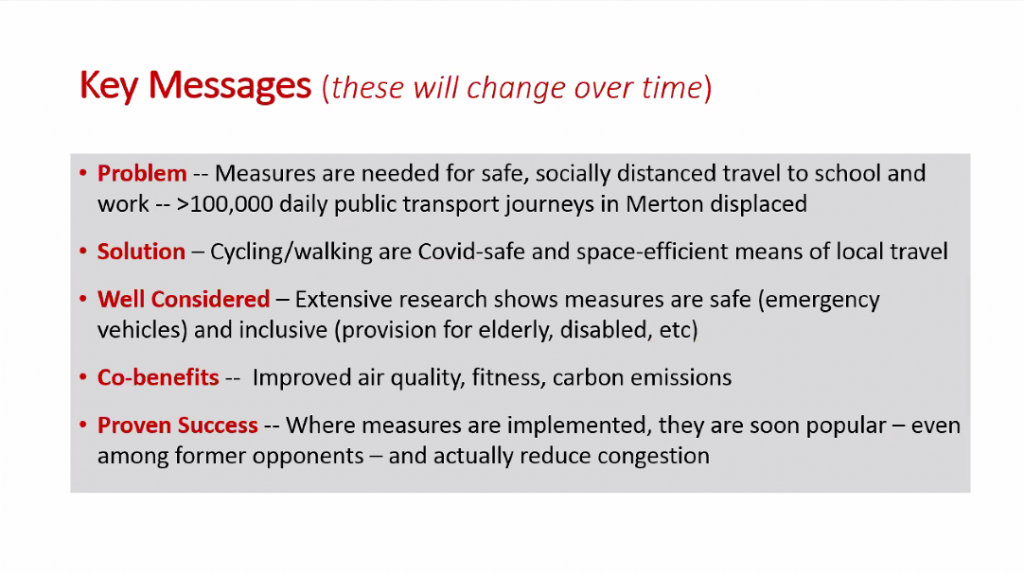
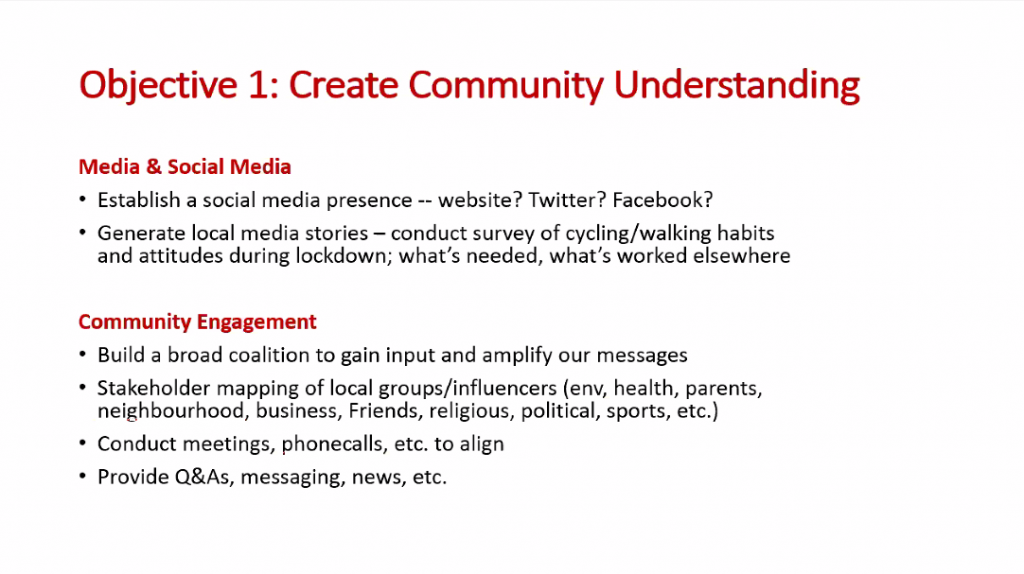
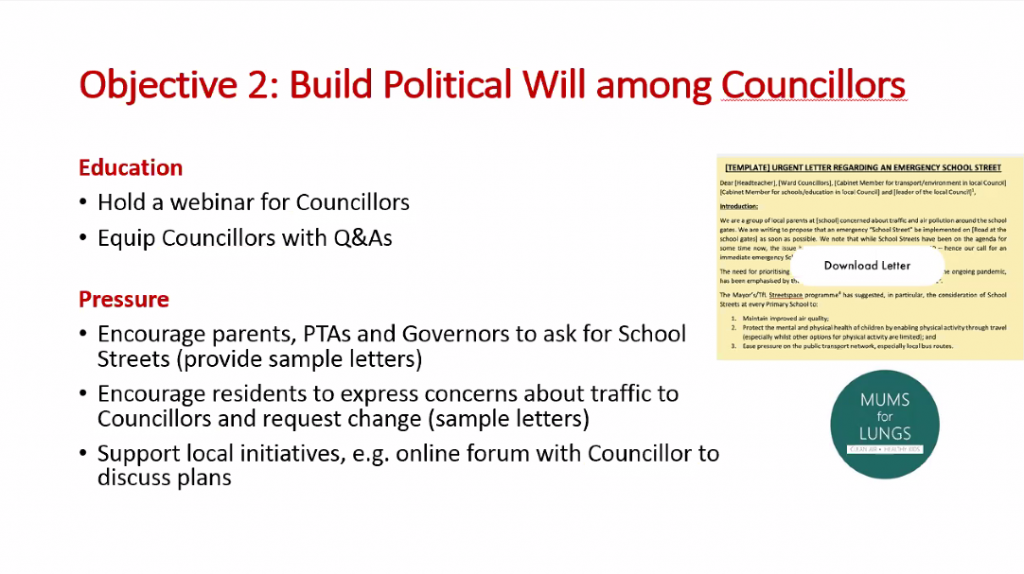
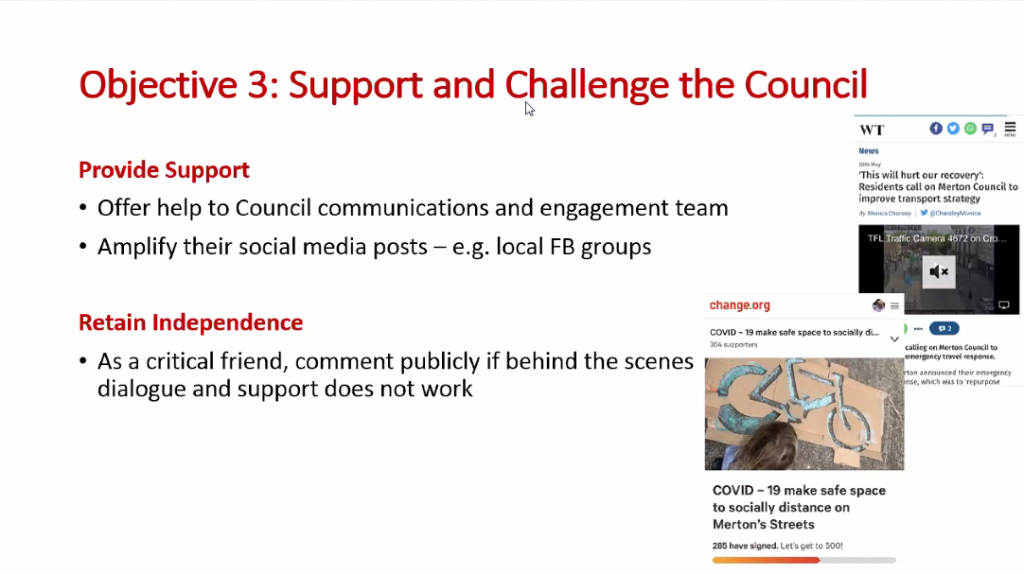
Welcome and overview
Luke McCarthy welcomed everyone to the group, and outlined the agenda for the call.
He reminded people of the purpose of the group, and reminded people that we now have a web page hosted by Merton Cyclng.
Update from Paul McGarry, Head of Future Merton
Over 110 representations from individuals and groups, over 350 individual projects and suggestions, has now been shared with Future Merton/ Merton Council.
Council focusing on putting in funding bids to TfL and DfT this and next week
Grouping projects under themes:
- Town centres and support businesses – footway
- Schools
- Cycling – quick wins and bigger more strategic
- LTNs
Funding: will use criteria to prioritise for funding, govt funding is for temporary measures; TFL more long term
Currently preparing a report for Cabinet – will be in the public domain by Monday – updated strategy, engagement reach, prioritisation of bids. The Council won’t know what can be delivered until they know what funding is available.
Temporary works
- Issue with stock of cones and water filled barriers and temporary bollards
- Delayed delivery of some projects
- Ashcombe train bridge – done today
- Haydons road bridge – materials expected tomorrow; scheme ready by Monday. Changed design due to materials. Delete road lines then input cycle barriers
- Worple Road – Sainsburys – suspending parking bays – building out footway, more space for bus stop queuing
- Wimbledon bridge – closing parking bays on Monday outside Gregg
- Centre Court entrance – remove taxi rank – alternative one on Queens Road by Boots
- Merton high street – 15 June — parking
- Plough Lane in design – cannot block driveway access – more permanent paint in cycle lane
- Kingston road – in design
- Wimbledon High Street – in design
Site investigations – strategic cycle network investigation east of borough – church road, London road n and s, in touch w TFL for Colliers Wood High Street, etc. etc. Merantun way cycle lanes. TFL plans for A24 and Morden Town centre.
Colliers wood to Sutton cycle way – both boroughs putting in bids. Merton section through Morden Hall Park.
Schools engagement – road safety teams reached out to 80 schools – not heard back from too many schools. Not all schools back in full. Able to manage queuing for now. Not crowding for now – different in September, so focussing on september for delivering Schools Streets and ANPR for enforcement.
- All Saints, bishop Gilpins, St Matth, Sherwood, Poplar, Ursuline
- School Streets – heard back from Wimbledon College, Ursuline High, St P&P in Mitcham, H Trinity in Wim, Aragon, Hollymount, Wim Com Prep
- 3 School Streets live already, Singlegate about to start
A lot of representations received by Future Merton are for LTNs – covering about 1/3 of the borough. Need to decide which are most important for traffic, safety, etc. We [the Council] won’t deliver all of them – Just biggest bang for the buck
Submitting bid to DFT to claw back money spent so far – then will spend more. TfL funding for longer term LTNs – DFT is for emergency measures. TFL deadline is 2X June so doing for next week as other boroughs already in.
Kingston Road – different parts – cycle measures. Where wider – can have segregated cycle lanes.
Question asked about:
-
- LTN’s seem to tick all of the boxes, will you admit they’re an economical way to achieve objectives? PMcG – need to get support for them, and prioritise the ones which will give the greatest return in Covid-terms
- Are there any point closures in the proposals included in the DfT bid as along with pop-up cycle lanes, these seem to be the two main proposals the DfT is looking to fund? PMcG: the schemes are those outlined in the original transport strat3egy and don’t include point closures.
- Post-meeting clarification via email from Cllr Whelton to Charles BArrabell on Fri, 5 Jun 2020 at 09:41 (and subsequently shared to MTRG email group) that “Yes our bid does comply with their guidelines which includes low traffic neighbourhoods which will involve modal flitters.”
Committee
Luke McCarthy outlined that he, Katie Meech, Kathryn Stewart and Lucy Taussig-Marstrand were loosely operating as a co-ordinating committee, and asked whether others would be prepared to get involved.
In response to a question from Jim Wagner, Luke stated that there were no formal positions currently, but was keen to get more pedestrians, parents, those from east of the borough and with contacts with local business.
The following members put themselves forward:
- Jim Wagner
- Daniela Tilbrook
- Mehmood Naqshbandi
- Paul Murray
- Vincent Leonary
Members confirmed that they were happy with the names of existing and new members.
Overview of next steps for each group
KS provided an overview of the three tasks that it was proposed that the Planning/Interventions Group could take forward. (see slide) She explained that the inclusion of ‘Prioritising’ schemes was at the request of the Council, and that it would have to be done at a very top level as the group did not have a mandate to make decisions about what could or should be prioritised. This was the role of the Council and elected Councillors as they were ultimately responsible.
KM provided an overview of the proposed work of the Comms and engagement group.
Communications and engagement breakout group
Katie outlined the objectives of the sub-group – see presentation.
Pippa observed that it was the same councillors attending, and asked whether the leaders of the political groups had power to compel others to attend.
Dan suggested contacting councillors by email as a route to engage more councillors. Paul McGarry had previously asked not to do so since many forward to the Council for handling. Dan also mentioned that less informed councillors contact certain people in their parties to guide responses.
Paul Murray can bring people from SusTrans to do webinar
In response to a question from Pippa, Katie stated that the group would potentially like to have a social media presence, provided we have the person-power.
Interventions break-out Groups
KS asked for general views on the three tasks outlined in the first part of the meeting:
- Mapping of proposals at concept level
- Data entry / tidy
- Publish
- Sifting and Prioritising
- Begin to define and ‘design’ Low Traffic Neighbourhoods to support LBM Engineers
- Nominated lead for each one?
- Site visits
- Map / collate in format useful to LBM
LT raised concerns about the criteria for any sort of prioritisation (Task 2) as many factors affect this, such as the propensity to cycle/walk data, the costs and benefits, and the views of those affected.
After some further discussion PMcG agreed that it was the responsibility of his team, not of this group, to prioritise as they have access to the traffic and accident data that would inform prioritisation, and it Officers who are responsible for advising Councillors. The funding bids also did not require the prioritisation of proposals as the DfT and TfL have different priorities. (TfL funding is for strategic routes and Low Traffic Neighbourhood type proposals.)
It was agreed that the second action of ‘sifting and prioritising’ would therefore not be taken forward by this group.
KS explained the difference between the other two tasks:
- Task 1 – “Mapping of proposals at concept level” would require some tidying up of the ideas submitted to LBM/Future Merton and shared with this group on Wednesday 3rd June, and then conversion into a map available online to everyone.
- Task 3 – “Developing” ideas for Low Traffic Neighbourhoods in more details to support the first phase of design work by LBM engineers, drawing on local knowledge, would be a second stage task. SC agreed that he would be able to support the mapping of these with his Open Street Map tool. KS suggested that he present on this at the following week’s meeting and that we discuss how we take this strand of work at the next meeting, when we would have a better idea of which areas LTN have already been suggested for. Before proceeding with this work we would need to discuss with the Highways Team what input was most useful or risk the work being redundant.
PMcG noted that so far most of the LTN proposals are in the west of the borough, and that these fit the criteria, such as Merton Park and the Pelhams.
The group discussed the best way to go about Task 1 (mapping the proposals that have already been submitted to Future Merton) in advance of them implementing the Common Place tool. The pro’s and con’s of Widen My Pavement and the Camden CC mapping tool shared by KS at the last meeting were discussed briefly before the group ran out of time. It was agreed that KS would take a decision and email around the group on Friday or Saturday morning with how to do this.
Post-Meeting Note: Decision to use the Camden CC mapping tool as it had the benefits of:
- Custom categories which can be aligned with LBM’s categorisation
- It draws through images of the locations, making it easier for people to understand what the issues are and potential benefits of the proposals.
KS sent around the spreadsheet and guidance on how to help with the collation of the relevant data on Saturday 6th.

